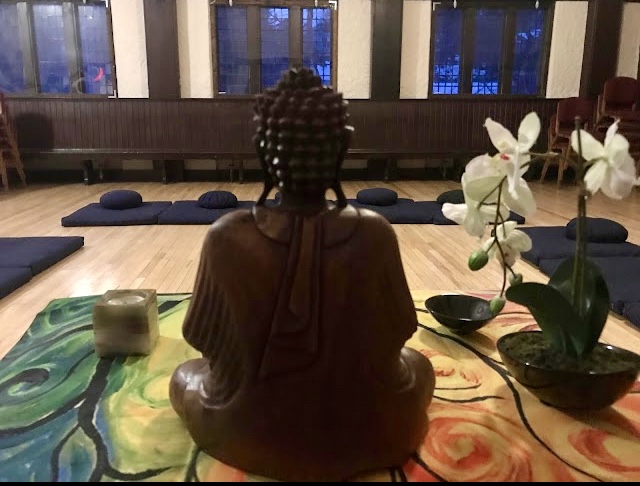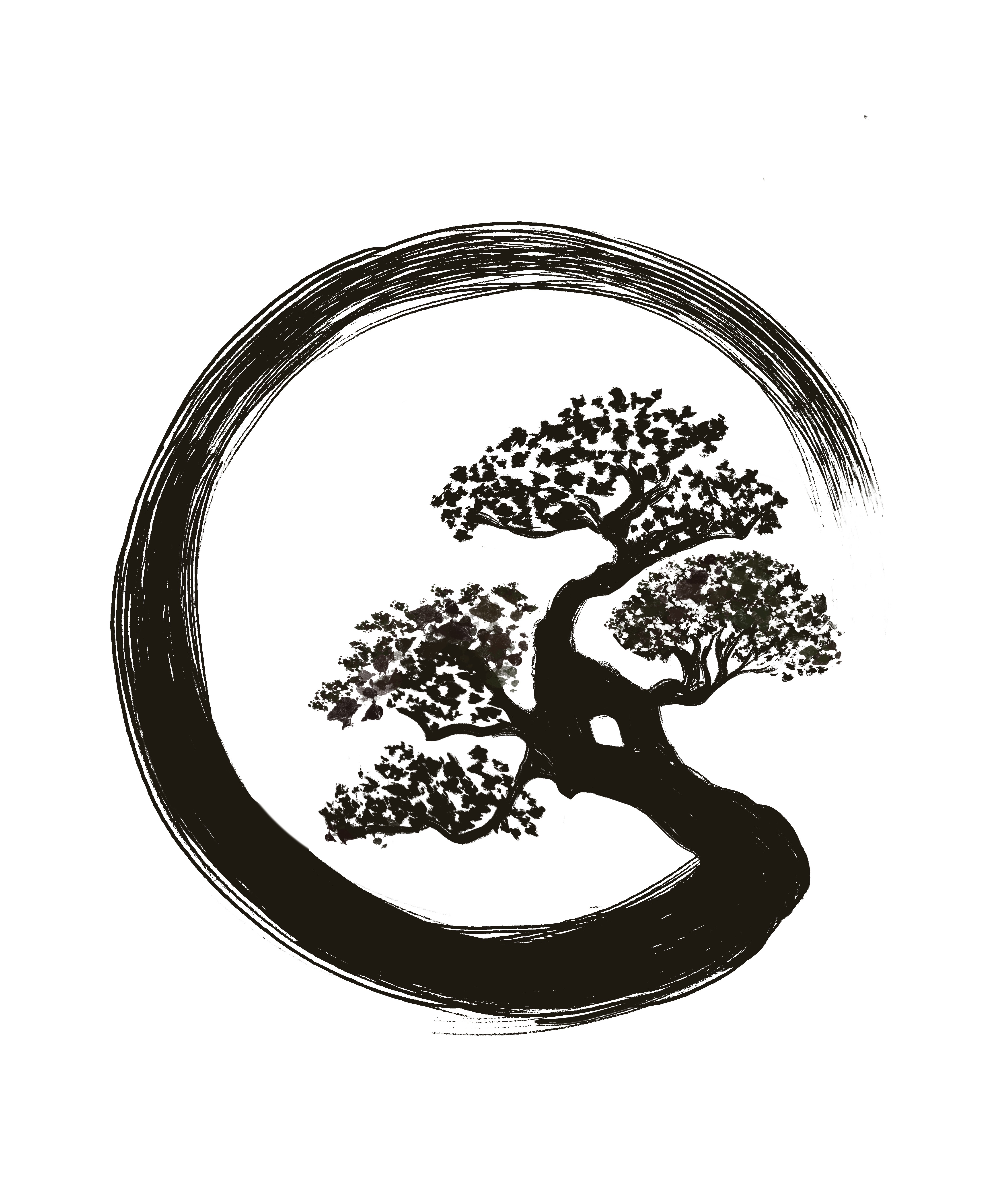What to Expect
At 7 PM on Wednesday evenings, volunteers set up the zendo at St. John’s. At 7:15, a practice leader from Morning Star Zen Sangha will then offer an orientation for new folks, including a brief introduction to zazen (the Zen style of meditation), postures that will help you sit comfortably and in stillness, meditation hall etiquette, Zen liturgy (chanting), and the Living Vow Zen school. If any of that is new to you, please consider coming to an orientation!

Our four primary encouragements for sangha practice are to sit still, be silent, maintain custody of our eyes, and do our best. Together we create a powerful container for practice that helps us shine the light within and realize true freedom.
The evening typically follows the following pattern, and as a newcomer, you might notice the way following along with the rituals deepens your meditation:
- A few minutes before the scheduled starting time, everyone will begin sitting quietly, on either a meditation cushion or in a chair.
- At 7:30, the service will begin. The practice leader will light incense and bow. The service itself consists of about 15 minutes of chanting selections from our sutra book, followed by two or more 25-minute periods of sitting meditation. Newcomers generally just listen to the chanting until they get the sense of each’s rhythm. During the second sitting meditation period, one of our teachers may give a talk, followed by a brief discussion.
- Between each period of sitting meditation is a brief period of walking meditation. Individuals needing to go to the restroom or to leave are encouraged to do so during the walking meditation period so as to minimize disturbances during the other parts of the service.
- Some sittings feature an opportunity to have a private interview (“dokusan”) with a Zen teacher. These are opportunities to ask questions about Zen practice, most particularly focusing on your own experience.
- The final sitting ends with a short chant and 3 bows, followed by socializing and fellowship.
If you have any questions, please get in touch.
A DEEPER DIVE INTO PRACTICE FORMS IN LIVING VOW ZEN
Living Vow Zen is a combination of elements from Japanese Sōtō and Korean Seon. Here are guidelines for practice at any Living Vow Zen sangha.
If you are new to Zen practice, please do not worry about memorizing these forms. You can just follow along when you join us.
These descriptions of forms are for in-person practice. If the service is online, we each adapt these forms as best we can to our context.
Entering and Leaving the Zendo
First, we silence our phones, remove our shoes, and leave them outside the zendo. When we enter the zendo (meditation hall, or if we are practicing online, the room in which we will be practicing), we pause at the door and bow with hands in gassho to the altar. Gassho position is hands palm to palm and fingers together. We bow from the waist. We then go to our places and bow to our cushions or chair. Then we turn and bow to the community before sitting down.
Before in-person zazen begins, others sitting directly across from us return our bows. Once the zazen period begins, those already seated no longer return bows to those who enter late but stay in our zazen posture.
Sitting Meditation (Zazen)
Zazen begins with the sound of the clappers and then three bells. From the moment we take our seats until the sound of the third bell fades, we can move to adjust our posture. After that, we sit in stillness.
For zazen, we sit in an upright and dignified posture with eyes slightly open, gaze resting on the floor. Whether we sit on a chair, a cushion, or a kneeling bench (seiza), we create a three-pointed foundation with our bodies. On a chair, both feet are flat and the third point is our buttocks on the chair bottom. We don't lean back in the chair, but sit gently upright. On a cushion or bench, our knees are on the rectangular floor mat (zabuton) and our buttocks are on the edge of the cushion or are supported by the seiza bench. Our hands form the “cosmic mudra”
We can adapt any of these postures to fit the needs of our bodies, including adjusting hand positions or adding extra cushions to support the knees or for the back against a chair.
During zazen we maintain stillness. We don't move, yawn, sigh, stretch, scratch, or look around. We do not leave the zendo unless there is an emergency, and we do not move unless we risk injury, in which case we can adjust our posture or move to a chair, then maintain stillness again. If we find ourselves slumping or falling asleep, we sit up straight again. If we cough or sneeze involuntarily, we lift our elbow or a tissue to cover our nose and mouth.
Chanting
During chanting, if we know the chant, we leave the liturgy book at our sides on the zabuton cushion. If we don't know the chant, we hold the book in front of us so that our posture stays upright without lowering our heads to look down. The hand position for holding the liturgy book is indicated by a symbol at the beginning of each chant for either gassho (palms together) with the book between our thumbs and index fingers, or hands open with our thumbs and pinkies on the inside of the book and the three middle fingers on the outside like a music stand. You can look to the chant leader for demonstrations of these postures during the Sutra service. We avoid placing the liturgy book on the floor.
Walking Meditation (Kinhin)
When the first zazen period ends, two bells indicate that we should bow and come to standing. Then, at the sound of the clappers, we bow again and line up behind the practice leader for kinhin (walking meditation). At the next sound of the clappers, we bow a third time and bring our hands into the kinhin position (shashu) with the left hand held in a gentle fist at the lower ribs and the right hand covering it lightly. We then walk in step with the person in front of us, staying no more than an arm's length behind. When the clappers sound again, we bring our hands into gassho and, staying in line, walk quickly until we reach our places. At the next sound of the clappers, we bow to each other and then turn (in the direction of the altar) and bow to our seats before sitting for the next period of zazen.
Prostrations
After a single bell at the end of the final sitting period, we bow but stay seated to chant “The Four Bodhisattva Vows,” after which there will be one bell, indicating another seated bow, then two bells indicating that we should rise. We come to standing and face the altar to do 3 standing bows or full prostrations, depending on our physical capabilities. Bells indicate when to bow.
To begin a full prostration, we bow in gassho and then, without moving our feet, come down to our knees. Our forehead and forearms are brought to the floor with hands resting palm up. Then we lift our arms from the elbows so that the hands rise up and then lower. Then we come back to standing with our hands in gassho.
Individual Meetings (Dokusan)
A stick will be passed from person to person in the zendo during dokusan periods. We do not bow when passing or receiving the stick. When the stick comes to us, we pass it to the next person if we do not want an interview. If we want an interview, we hold onto the stick and wait for the teacher's bell to ring, then pass the stick to the next person in the zendo.
When leaving the zendo for dokusan, we do not bow as we exit. When we arrive at the dokusan room, we do one bow and then close the door. We move to stand behind the cushion facing the teacher and do a second bow. These bows can be done standing or as full prostrations.
We then take our seats, and when we are settled, we say our name and our meditation practice (for example, breath, shikantaza or kōan practice), even if we have met the teacher a hundred times before. Dokusan is intended to be brief and entirely focused on our practice. The teacher signals the end of the meeting by bowing, and we return this bow. Then we stand, do one more bow, and leave the door open as we return to the zendo.
When returning to the zendo, we don't bow at the threshold. Returning to our places, we bow to our cushion or chair and then to the community (these bows are not returned). We then settle back into our zazen posture.
Be Gentle with Yourself
Please don't worry about making mistakes as you learn the forms. The key is paying attention to our sangha and following along as best we can. This is a form of practice in and of itself. Remember that Zen practice is not about right and wrong. Our together-practice creates a container that allows us to discover freedom within this human form.

